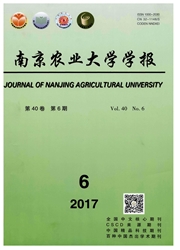

 中文摘要:
中文摘要:
[目的]本文旨在探明菊属植物自交亲和性及自交后代部分性状表现,为菊属植物杂交育种提供中间材料。[方法]采用花药离体萌发、花药活体萌发的方法对22份菊属材料进行测定。通过对自交结实材料种子结实率和亲和指数的测定来判定菊属植物的自交亲和性。采用SPSS 20.0软件对自交后代与亲本进行性状差异分析。[结果]泉水野菊、成都野菊、狼山野菊、‘钟山金山’‘钟山金桂’‘钟山紫荷’‘钟山醉容’自交结实,自交结实率分别为1.39%、0.58%、1.07%、0.28%、0.68%、3.30%、0.21%,而‘Qx-017’、小红菊、‘贡菊’‘钟山丹桂’等14份菊属植物自交不亲和。自交种子具有低萌发率、低成苗率的特点。多数自交后代的花心直径、花序直径、舌状花数、管状花数低于亲本。[结论]菊属植物普遍具有自交不亲和性,多数自交后代生殖器官特性发生了衰退。
 英文摘要:
英文摘要:
[ Objectives] This study investigated self-compatibility of 22 materials in genus Chrysanthemum and some characteristics of selfing progeny in order to provide intermediate materials for chrysanthemum hybrid breeding. [ Methods ] The self-compatibility was determined by pollen germination in vitro and in vivo for 22 materials in genus Chrysanthemum. Self-seed setting rate and affinity index were used in seeds of selfingprogeny. In addition, SPSS 20.0 sofeware was used to analyze the difference in characteristics between selfingprogeny and the parents. [ Results ] C. indicum Quanshui, C. indicum Chengdu, C. indicum Langshan, and C. morifolium' Zhongshanjinshan' ' Zhongshanjingui' ' Zhongshanzihe' and' Zhongshanzuirong' are self-compatible. Self-seed setting rate is 1.39% ,0.58%, 1.07%, 0.28%, 0.68%, 3.30%, 0.21%, respectively. Whereas lg materials, such as ' Qx-017 ' , C. chanetii, 'Gongju' and' Zhongshandangui' are self-incompatible. Selfed seeds have the characteristics of low germination rate and low seedling rate. Flower disc diameter, inflorescence diameter, ray florets number, and tubular florets number of most of selfedoffsprings are lower than those of the parents. [ Conclusions ] Plants in Chrysanthemum are generally self-incompatible. Inbreeding depression exists in reproductive organs of most selfedoffsprings.
 同期刊论文项目
同期刊论文项目
 同项目期刊论文
同项目期刊论文
 期刊信息
期刊信息
